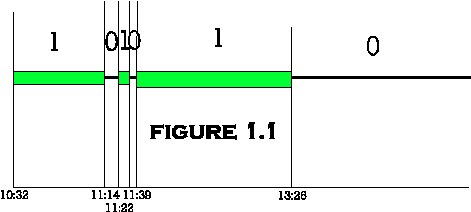When projected before our eyes, the exposed film of the movies consists of 40% black, or negative space, interspersed with 60% of marginally different static images. It is possible to refer to this motion as a binary code of 1(on) and 0(off). Similarly one could use this system to chart regular movement and interaction in a series of 1 and 0 whenever two characters interact as a series of ‘off’ and ‘on’. For example, when I do not see my friend, they to me exist as 0, and similarly from my comrade’s perspective, I do not exist for that time when we are apart. From this it would seem possible to chart a timeline for an ordinary day that consisted in these such dyads (in a system that mimics the linear temporal notation of a scene of action on many computer animation programs). [Wince at Figure 1.1] A map which serves to navigate one through a pre-set unit time will therefore be a personal project recognisable only in the first-person, by each first person, just as the primary vision from which it was translated.

So which parts do we occupy? The black or the tinted filmic transparent? The negative or the positive? Each person exists only ever in the positive as an ordering body. Every time we blink we erase the object from our visual field - the viewing subject kills his object - replacing it with ‘negative’ darkness or absence. Perhaps even replacing it with ourselves. Indeed, blinking is perhaps the easiest and most frequent way that we see inside ourselves. But, as we blink so (too) our (human) object blinks and erases us. In this scenario, we die several thousand times each day and are resurrected. For the passer-by we are recreated by them and destroyed rarely even lasting as a memory. It is as if my image is created by someone who dreamt of my features in the order that they occur on my body at that precise moment, therefore transporting me to the place that I currently occupy - that space before their gaze. My image created, it is propelled through the eye of the beholder to impress lightly on the brain, only to be erased by the next dreamt assortment of features. This is a process of selection - a game of chance and selection. The image that will linger is that that comes closest to some imagined perfection or conversely furthest from this notion. In this sense, I create those around me and once I have agreed upon the distinctive features of each, I am able to recall them at will - to meet with them and to create the secret lives of my friends.
But there is always the dark. The notion goes that two-fifths of what we see is absence. Framed circularly one can say that at the centre of our vision is a whole greater than the width of the positive space. [Side glance to Figure 1.2 - not yet on the barricades] In fact mapped like this, vision itself forms the negative model of an eye. The iris here sees everything, conjures up and creates acquaintances, whilst the pupil is blind, blocking complete sight that would (really) blind us. Sight is never all positive or all negative even when broken into constituent parts as here. The key to vision and sight is that it is fundamentally founded on the flicker between these two stages. Candlelight perhaps best approximates this stage. No wonder then that candlelight is employed to recreate a romantic ambience. By this light one is able is constantly refresh and to refine the image of the object before their gaze. The desiring subject refinds the object of that misplaced desire several times each minute. Similarly tracking an animal or enemy by flaming torchlight helps to keep sentiment and sympathy at bay by constantly refreshing our vision of the object’s horror.
From a potentially revolutionary model of vision, we come to recognise its basis in time - itself anchored theoretically by its atemporal constituents. Through vision, as we can understand it through our confrontation with the movies, we stand as the ordering body adrift in a field of ordering bodies, whirring from one orbit to the next in a constant mean state between annihilation and exaltation. The binary model offers us dyads of opposing polarity, but the constant blinking between 1 and 0 condemns us to the infinite mediocrity of GODS.
 Back to the FE essay index
Back to the FE essay index 